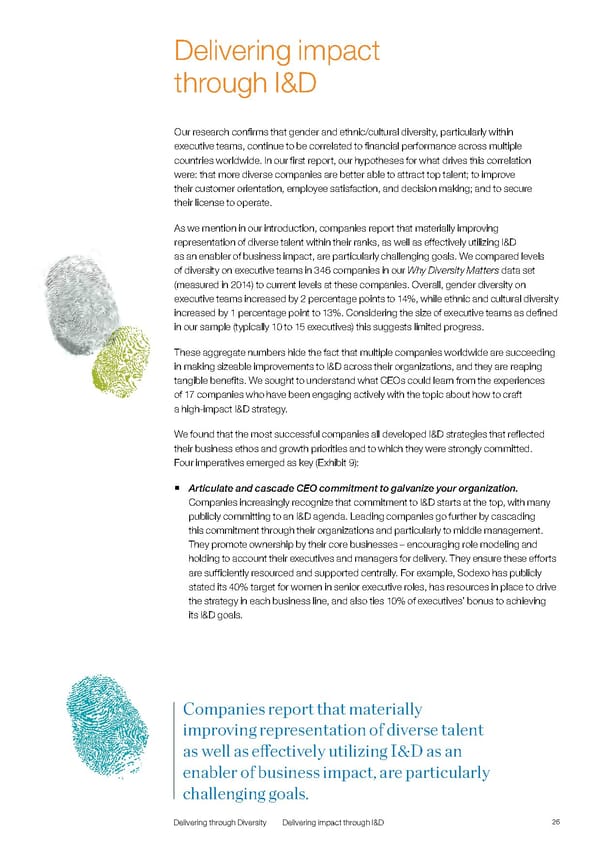Delivering impact through I&D Our research confirms that gender and ethnic/cultural diversity, particularly within executive teams, continue to be correlated to financial performance across multiple countries worldwide. In our first report, our hypotheses for what drives this correlation were: that more diverse companies are better able to attract top talent; to improve their customer orientation, employee satisfaction, and decision making; and to secure their license to operate. As we mention in our introduction, companies report that materially improving representation of diverse talent within their ranks, as well as effectively utilizing I&D as an enabler of business impact, are particularly challenging goals. We compared levels of diversity on executive teams in 346 companies in our Why Diversity Matters data set (measured in 2014) to current levels at these companies. Overall, gender diversity on executive teams increased by 2 percentage points to 14%, while ethnic and cultural diversity increased by 1 percentage point to 13%. Considering the size of executive teams as defined in our sample (typically 10 to 15 executives) this suggests limited progress. These aggregate numbers hide the fact that multiple companies worldwide are succeeding in making sizeable improvements to I&D across their organizations, and they are reaping tangible benefits. We sought to understand what CEOs could learn from the experiences of 17 companies who have been engaging actively with the topic about how to craft a high-impact I&D strategy. We found that the most successful companies all developed I&D strategies that reflected their business ethos and growth priorities and to which they were strongly committed. Four imperatives emerged as key (Exhibit 9): ƒ Articulate and cascade CEO commitment to galvanize your organization. Companies increasingly recognize that commitment to I&D starts at the top, with many publicly committing to an I&D agenda. Leading companies go further by cascading this commitment through their organizations and particularly to middle management. They promote ownership by their core businesses – encouraging role modeling and holding to account their executives and managers for delivery. They ensure these efforts are sufficiently resourced and supported centrally. For example, Sodexo has publicly stated its 40% target for women in senior executive roles, has resources in place to drive the strategy in each business line, and also ties 10% of executives’ bonus to achieving its I&D goals. Companies report that materially improving representation of diverse talent as well as effectively utilizing I&D as an enabler of business impact, are particularly challenging goals. Delivering through Diversity Delivering impact through I&D 26
 Delivering Through Diversity Page 27 Page 29
Delivering Through Diversity Page 27 Page 29